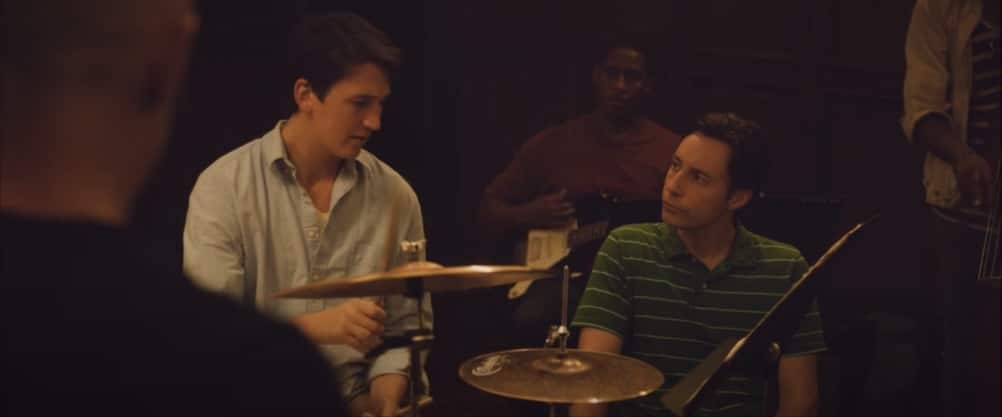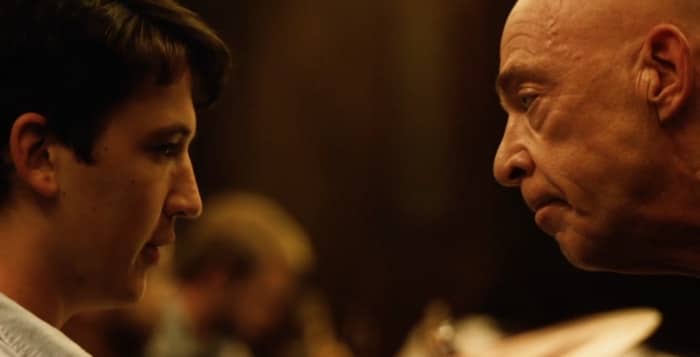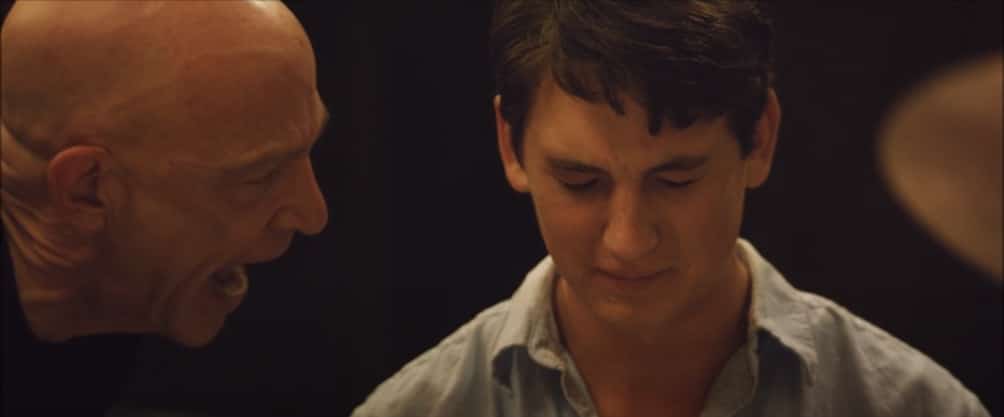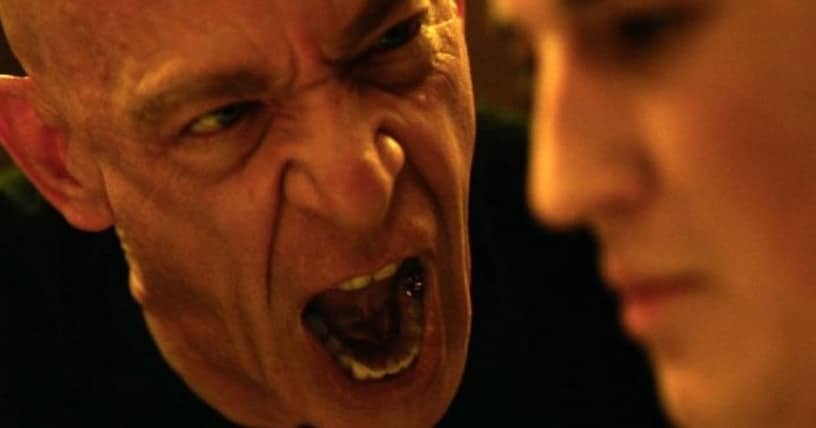In this series, we’ll take a look at great, well-known scenes from films and TV. We’ll analyse these scenes to figure out what makes them work so well, what they add to the overall piece and why they prove so memorable. In this article we’re going to take a look at the Whiplash scene – ‘Not quite my tempo’.
We’ll look at:
- The Importance of this Whiplash Scene.
- The Pacing of the Scene.
- The Important Elements in the Makeup of the Scene.
- The Horrifying, Compelling Nature of the Core Character Dynamic.
- And Why is ‘Not Quite My Tempo’ so Memorable?
A Shift in Time
Not long after the film was released ‘not quite my tempo’ was a quote familiar to many. It’s a good line but why does it feel quite so memorable? It’s a line that perfectly encapsulates characterisation, themes and narrative. But it also comes at a point in the film that signals a shift.
- Andrew Neiman (Miles Teller) has recently been inducted into the Shaffer Conservatory Studio Band.
- He’s a talented drummer and on the up, getting accepted into this prestigious band.
- The band’s leader is Terrence Fletcher (J.K. Simmons).
- Terrence’s reputation precedes him and Andrew witnesses this first hand, as Terrence berates a member of the band during the first rehearsal he’s a part of.
However, Andrew is talented at what he does. Surely he can escape Terrence’s wrath? During a rehearsal, Andrew’s moment comes. His first time at playing with the band…
This is a big moment and we’re happy for Andrew, if terrified at what might be in store for him. However, Fletcher still seems supportive of Andrew. Before they start he says warmly ‘Neiman, just do your best’. Andrew responds with an excited smile.
The positivity continues…
- Andrew starts playing with the band and it seems to be flowing.
- Fletcher wanders over to Andrew as he is playing and seems pleased.
- Andrew is desperate to impress Fletcher and we can see this in his body language, watching for Fletcher’s reaction.
- Fletcher decries ‘We got Buddy Rich here!’ and Andrew is delighted, smiling coyly and even smugly.
But then it stops. From this point on there is no turning back. Barely a minute has passed before Fletcher clenches his fist and calls the band to stop. It’s a stark and scary image, Fletcher clenching, barely holding back his emotions, which will soon break like a wave.

Everything Changes.
Fletcher says ‘Little trouble there, pick it up at 17’, indicating that Andrew messed up a little so they’ll go again. He’s still understanding at this point. It’s not a big deal, just a little mistake.
But then they start again, going for little more than 5 seconds before Fletcher stops Andrew and the band again. Fletcher is still contorted but trying to be polite as he delivers the immortal line to Andrew: ‘Not quite my tempo’. Andrew looks scared now.
Fletcher starts the band again and then stops. Then starts. Then stops, trying to figure out what Andrew is doing wrong. He’s still relatively calm and polite at this point but the tension is building, both in him and in Andrew.
“Not quite my tempo. It’s all good, no worries.”
This exchange continues on for a few more minutes. Fletcher is still calm and Andrew seems frustrated as Fletcher says he’s ‘rushing’ or ‘dragging’ each time he interrupts him. Finally, Andrew seems to nail it. Fletcher walks away, nodding. Andrew seems like he has finally got it right.
But no. And this time there is no polite feedback as Fletcher hurls a chair in Andrew’s direction, Andrew ducking out of the way.
‘Not quite my tempo’ is the final act of polite feedback that Terrence Fletcher gives Andrew Neiman before he breaks, dragging Andrew into a world of abuse and castigation. ‘Not quite my tempo’ comes to be an ironic expression of Fletcher’s criticism.
It’s a politeness that we don’t see for the rest of the film, at least towards Andrew. How Fletcher comes to torture Andrew puts this scene into a new light than on first appearance. ‘Not quite my tempo’ is not a helpful and considered piece of criticism.
It turns out to be a shark fin on the water, a terrifying signal of the monster below the surface.
The Pacing of the ‘Not Quite My Tempo’ Whiplash Scene
Part of what makes the ‘not quite my tempo’ scene so compelling is its pacing and structure. Put simply, it builds and builds.
The tension in this particular Whiplash scene has to do with what we know and don’t know…
- We know Fletcher has a tendency to abuse his pupils.
- We know Andrew is keen to impress, this dependance almost desperate given how much pressure he places on himself to succeed as a drummer.
- What we don’t know is how exactly Fletcher feels about Andrew. We suspect that Fletcher has disdain and indifference towards him (as established by the opening scene in which they meet each other and Fletcher seems unimpressed by Andrew’s skill). But there is still hope that Andrew is good enough to impress Fletcher.
- We don’t know how Andrew will react. We suspect he is fragile to such harsh criticism. But we can’t be certain until we see it.
- What we also don’t know is the limits and range of Fletcher’s abuse. We’ve seen him shout abuse at a student already in a previous scene. But Fletcher’s composure is chilling. He’s someone who holds onto tension and anger, with the feeling that it will spill out inevitable.
- This previous scene of abuse is key to the power and tension of this ‘not quite my tempo’ scene. Without it we wouldn’t have as much insight into Fletcher’s tactics and wouldn’t have the sense that he could explode at any moment.
In this ‘not quite my tempo’ Whiplash scene, what we know and what we don’t know meet in the middle to form a rubber band of tension. We’re constantly looking for clues as to what is going to happen – is Fletcher going to explode or is Andrew going to succeed and fit in?

A Rubber Band of Tension
The pacing of the scene is key to amplifying this tension. The scene ebbs and flows in terms of energy. The writing here is acutely of aware of the effect it’s having on the audience and how that effect can be manipulated to amplify the tension as much as possible.
Below is how the scene ebbs and flows and the intended effect on the audience….
- The scene starts off slow – Fletcher starts the rehearsal with a reassuring nod to Andrew ”Neiman, just do your best’ – Calm but suspect (we know Fletcher has a dark side).
- The scene bursts into action – The band starts, Andrew plays well and Fletcher rewards him with praise – Delighted if surprised (Previous action suggests Fletcher isn’t that likely to be this positive).
- Everything stops abruptly – Fletcher stops the rehearsal and offers Andrew kind criticism – Nervous (worried that Andrew got something wrong and with the knowledge that Fletcher doesn’t take well to students playing out of time).
- Then, for about the next minute or so, we’re on edge – Fletcher continually interrupts the rehearsal to critique Andrew – Spiralling and building nerves (we know this can’t end well now, Andrew continually messing up meeting Fletcher continually being polite and patient is an equation that doesn’t add up).
- The tension is amplified in this section by the fact that Andrew is visibly nervous (he starts at the wrong time and seems itchy) and that Fletcher moves closer to Andrew, his presence looming over him in the frame.
- Then a sweet release – Andrew seems to get something right as Fletcher walks away nodding and lets Andrew play – A slight relief of tension.
- Then shock and silence – Fletcher throws a chair at Andrew, who ducks out of the way – Shock but release (we knew this was coming and now it has, what will come next?).
A Release of Tension
What follows is two and a half minutes of abuse as Fletcher shouts at Andrew, slaps him and humiliates him.
The tension is no longer in what will or won’t happen, it’s in an immersion in what does happen. This is painful viewing. The tension has now been released. We’re right there in it and watching it unfold is horrifying but also something we can’t take our eyes off.
“Now answer my question, were you rushing or were you dragging!?”
This ‘not quite my tempo’ scene shows the very essence of how to build tension. Whilst we are watching a teacher circle a student, we could just as easily be watching a shark circle a swimmer.
- The tension is palpable with the knowledge of what the shark could do to the swimmer if it chooses.
- This is about power as much as it is anything else. When the power is so clearly weighted in one direction, the potential crushing effect of that power is always in the air.
- When the shark does eventually get its teeth on the swimmer, the tension of what will or won’t happen is released and what’s left is the horror.
An Important Observer

An important barometer throughout the ‘not quite my tempo’ Whiplash scene sits next to Andrew the entire time. His name is Carl and he’s the drummer with which Andrew is in competition with.
We’ve already met Carl when Andrew sat next to him during a rehearsal, tasked with changing the sheet music over when necessary. Now it’s Andrew’s turn in the hot seat and Carl is feeling the pressure. Will this newbie be taking his place?
Carl serves as a crucial temperature check for the scene throughout. He’s the only other (properly) visible character in the scene. His presence, therefore, is not accidental. It’s him, Andrew and Fletcher.
Yes of course the scene is actually filled with dozens of other characters. But these are periphery characters, whose expressions we barely see and whose presence is largely unimportant to the main focus of the scene.
The Third Wheel
Carl’s expressions and demeanour change throughout the scene, in line with the ebb and flow of energy and emotion.
- When Andrew appears to be doing well, with praise from Fletcher – Carl seems disgruntled, even rolling his eyes.
- Then when Andrew starts to get things wrong, Carl seems confused. He checks Andrew out, trying to figure out what he’s doing wrong. When Fletcher asserts what Andrew is doing wrong, Carl agrees by nodding his head.
- It’s clear whose side Carl is trying to be on. He’s with the expertise of Fletcher.
- Carl knows his place now, he increasingly senses Andrew won’t replace him. He even seems to take pity in Andrew in the way he looks at him as he plays and gets things wrong.
- He studies him like an observer of a poor gazelle about to be ravaged by a lion. What is this gazelle not doing right to evade the lion’s jaws? Where did it go wrong?
- By the end of scene, after Fletcher’s abuse of Andrew, Carl jumps into Andrew’s seat to replace him. He’s not visibly gleeful but he’s confident.
- After a momentary fear that he would be replaced, he now knows his place is safe and that he has the expertise and skill that Andrew doesn’t have.
Carl as a Bellwether
Carl hammers home the ruthless competitiveness that is a hallmark of this music school. He’s a face to this competitiveness. We don’t know how the rest of the band react to Andrew’s abuse. But Carl provides us with what we need to know.
Crucially, during the two minutes of abuse that Fletcher hurls at Andrew, Carl isn’t present. The camera is up close to Andrew and Fletcher, almost as if no one else is even in the room. Carl’s very absence in this exchange is again, telling. His reaction is almost inconsequential, suggesting that the frequency with which this abuse happens makes it unremarkable.
There is one moment in which this section cuts away to the band (when Fletcher actually invokes them). But aside from this tiny exception, the focus is myopically on Fletcher and Andrew.
Without Carl, Andrew and Fletcher’s exchange would occur in a vacuum. Carl is an important feature of this ‘not quite my tempo’ Whiplash scene overall. He’s a character that acts as a forewarner, signalling that something is afoot before it happens. Carl can sense what is going to happen before Andrew does and before the audience does.
The Actual Content of the Scene

Of course, the essentials of what actually happens in the ‘not quite my tempo’ Whiplash scene, as well as how it is structured, are what makes it so compelling. The abuse Fletcher reigns down on Andrew is at once difficult and compelling to watch.
This moment has been coming. We’ve seen the pressurised environment of the music school. We’ve seen Andrew’s desperation to succeed and his fragility. And we’ve seen hints and glimpses of Fletcher’s monstrous technique and personality.
The ‘not quite my tempo’ scene is where all this build up comes to a head.
What’s more, Fletcher’s abuse is hard to look away from. It challenges the audience on a number of different levels…
- The emotional abuse is raw and cruel. It’s unfiltered bullying. Fletcher invokes Andrew’s parents’ divorce, makes fun of Andrew crying and forces him to shout to the band that he’s “upset”.
- There is physical abuse too, as Fletcher slaps Andrew repeatedly. This is shocking. We have come to suspect Fletcher is an emotional bully (seeing him in a previous scene mock a student’s weight). But physical too? This is hard to watch.
- What complicates all this is the personality and charisma infused in Fletcher’s characterisation. He’s a horrible character, one you wish you could burst through the screen and confront.
- But it’s also hard to ignore the humour in some of his words and the intimidating figure he cuts at the head of the band. Fletcher is given some memorable one-liners, ones that despite how horrible they are, are often hard to not resist a smirk at.
“Are you one of those single tear people? Do I look like a double fucking rainbow to you?”
The Showpiece Whiplash Scene

The ‘not quite my tempo’ scene feels like the showpiece Whiplash scene for a number of reasons.
- It’s where the story breaks. There’s no going back now. What felt like a look at the brutal experience of music school becomes a story focused on the abuse of an all powerful teacher and the effect he has on a student.
- The scene releases tension that has been building from the very opening scene.
- Fletcher establishes himself as a ruthless, charismatic villain. Whilst Andrew reveals his heartbreaking vulnerability and fragility.
- The events that take place within the scene are distinctive in their extremity. We thought this was a music school where teachers are hard on students. But it’s much more. It’s an environment that breeds the worst kind of competitiveness, pressure and abuse of power.
‘Not quite my tempo’ is a line that has already gone down in cinematic history. It’s a line that hides a lot within it, encased in a memorable and expertly crafted scene.
There’s certainly no ‘rushing or dragging’ in the execution of this scene. This doesn’t stop us, however, from feeling like a recipient of Fletcher’s abuse, rather than just a mere witness.
– What did you think of this article? Share It, Like It, give it a rating, and let us know your thoughts in the comments box further down…
– Struggling with a script or book? Story analysis is what we do, all day, every day… check out our range of script coverage services for writers & filmmakers.
Get *ALL* our FREE Resources
Tackle the trickiest areas of screenwriting with our exclusive eBooks. Get all our FREE resources when you join 60,000 filmmakers on our mailing list!


Good tempo
Excellente!